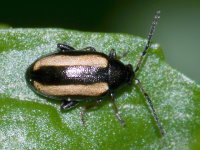Phylum Arthropoda (Arthropods) ➔ Subphylum Hexapoda (Hexapods) ➔ Class Insecta (Insects) ➔ Order Coleoptera (Beetles) ➔ Family Chrysomelidae (Leaf beetles)
Phyllotreta nemorum (Linnaeus, 1758)
Gelbstreifiger Kohlerdfloh Turnip Flea Beetle
Synonyms and other combinations:
Chrysomela nemorum Linnaeus, 1758 | Phyllotreta künnemanni Reitter, 1905 |
Further vernacular names:
Yellow-striped Flea BeetleClassification:
Phyllotreta nemorum belongs to the subfamily Galerucinae, tribe Alticini.Distribution:
Temperate Palaearctic (except North Africa), introduced into Australia.Widely distributed in Germany.
habitat:
Ruderal areas, sunny grassland, sandy areas, acres.Description:
The Turnip Flea Beetle is a small beetle with a body length of 2.5 - 3 mm and metallic shimmering head and pronotum. The elytra have a yellow, almost equally wide longitudinal band and a wide black seam, which is hardly constricted at the front. The tibiae and tarsi are light-coloured. In the male, antennal segments 4 and 5 are cylindrically thickened.Similar species:
There are several similar species.Biology:
After hibernation adults of Phyllotreta nemorum appear from March or April and start feeding on their host plants. Host plants of the oligophagous species are crucifers (Brassicaceae) and Cleomaceae occuring only as ornamental plants in Central Europe.From the middle of May, about 5 - 10 days after mating, the females begin to lay eggs. One female lays about 150 eggs. The eggs are usually attached to the host plant in small groups. After hatching, the larvae mine in older leaves. They undergo 3 larval stages in about 15 - 30 days and also moult in the mine. The fully-grown larvae drop to the ground to pupate. The pupation takes place in an earth cave. From August, after a pupal period of 2 - 3 weeks, the adults of the new generation appear.
Phyllotreta nemorum forms one to two generations per year.
References, further reading, links:
- Arved Lompe: Die Käfer Europas - Ein Bestimmungswerk im Internet
- Rheinheimer, Joachim, & Hassler, Michael: Die Blattkäfer Baden-Württembergs, 2018, 928 pages, Kleinsteuber Books (Karlsruhe), ISBN 978-3-9818110-2-5
- Agelastica alni
- Altica sp.
- Aphthona nonstriata
- Bromius obscurus
- Bruchus rufimanus
- Bruchus sp.
- Cassida nebulosa
- Cassida rubiginosa
- Cassida sp.
- Cassida stigmatica
- Cassida vibex
- Cassida vibex/bergeali
- Cassida viridis
- Chrysolina fastuosa
- Chrysolina haemoptera
- Chrysolina hyperici
- Chrysolina lucidicollis
- Chrysolina oricalcia
- Chrysolina sp.
- Chrysolina sturmi
- Chrysolina varians
- Chrysomela populi
- Chrysomela tremula
- Chrysomela vigintipunctata
- Clytra laeviuscula
- Clytra quadripunctata
- Coptocephala sp.
- Crepidodera aurata
- Crepidodera aurea
- Crepidodera fulvicornis
- Crioceris duodecimpunctata
- Cryptocephalinae sp.
- Cryptocephalus moraei
- Cryptocephalus nitidus
- Cryptocephalus pusillus
- Cryptocephalus sp.
- Donacia bicolora
- Donacia cinerea
- Donacia marginata
- Donacia versicolorea
- Galeruca tanaceti
- Galerucella s.l.
- Gastrophysa viridula
- Gonioctena decemnotata
- Gonioctena quinquepunctata
- Gonioctena quinquepunctata/intermedia
- Gonioctena sp.
- Gonioctena viminalis
- Lema cyanella
- Leptinotarsa decemlineata
- Lilioceris lilii
- Lochmaea caprea
- Neocrepidodera ferruginea
- Neocrepidodera sp.
- Oulema melanopus/duftschmidi
- Oulema obscura
- Pachybrachis sp.
- Phratora sp.
- Phratora vitellinae
- Phyllobrotica quadrimaculata
- Phyllotreta armoraciae
- Phyllotreta nemorum
- Phyllotreta vittula
- Plagiodera versicolora
- Plagiosterna aenea
- Plateumaris sp.
- Podagrica fuscicornis
- Psylliodes sp.
- Pyrrhalta viburni
- Sphaeroderma sp.
- Xanthogaleruca luteola
